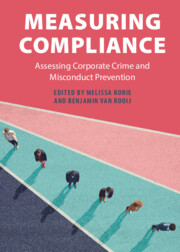Book contents
- Measuring Compliance
- Measuring Compliance
- Copyright page
- Contents
- Figures
- Tables
- Contributors
- 1 Measuring Compliance: The Challenges in Assessing and Understanding the Interaction between Law and Organizational Misconduct
- Part 1 The Compliance Industry, the State, and Measurement Needs
- Part 2 Quantitative Approaches to Measuring Corporate Compliance
- 5 Self-Report Surveys and Factorial Survey Experiments
- 6 The Use of Randomized Experiments for Assessing Corporate Compliance
- 7 Measuring Corporate Compliance: A Guide to Using Available Firm Data to Improve Employee Behavior
- 8 Measuring Compliance Risk and the Emergence of Analytics
- 9 Using Regulatory Inspection Data to Measure Environmental Compliance
- 10 Using Outcomes to Measure Aggregate-Level Compliance – Justifications, Challenges, and Practices
- Part 3 Qualitative Approaches to Measuring Corporate Compliance
- Part 4 Mixed Methods and Building on Existing Compliance Research
- Index
- References
5 - Self-Report Surveys and Factorial Survey Experiments
from Part 2 - Quantitative Approaches to Measuring Corporate Compliance
Published online by Cambridge University Press: 17 February 2022
- Measuring Compliance
- Measuring Compliance
- Copyright page
- Contents
- Figures
- Tables
- Contributors
- 1 Measuring Compliance: The Challenges in Assessing and Understanding the Interaction between Law and Organizational Misconduct
- Part 1 The Compliance Industry, the State, and Measurement Needs
- Part 2 Quantitative Approaches to Measuring Corporate Compliance
- 5 Self-Report Surveys and Factorial Survey Experiments
- 6 The Use of Randomized Experiments for Assessing Corporate Compliance
- 7 Measuring Corporate Compliance: A Guide to Using Available Firm Data to Improve Employee Behavior
- 8 Measuring Compliance Risk and the Emergence of Analytics
- 9 Using Regulatory Inspection Data to Measure Environmental Compliance
- 10 Using Outcomes to Measure Aggregate-Level Compliance – Justifications, Challenges, and Practices
- Part 3 Qualitative Approaches to Measuring Corporate Compliance
- Part 4 Mixed Methods and Building on Existing Compliance Research
- Index
- References
Summary
Abstract: The use of self-report surveys in social science research is ubiquitous, yet the promise of such methods for the evaluation of business compliance has yet to be fully explored. This chapter details the unique benefits of adopting a survey approach generally in the study of compliance, as well as examining the benefits of “factorial survey experiments” more specifically. Specifically, surveys and factorial surveys have the potential to uncover noncompliance before it happens, provide insights into why noncompliance occurs, and can examine whether employee trainings or other internal efforts are effective in promoting compliance behavior. Throughout the chapter, the utility of these methods for both academic scholars as well as compliance practitioners is emphasized in an attempt to encourage people within corporations to consider moving beyond a reliance on data collected by the corporation in the course of everyday business processes – ideally in partnerships with scholars.
The chapter begins with a brief history of survey research and how surveys have been used in compliance research, then provides an overview of the known benefits and weaknesses of the survey method. A description follows detailing more specifically how the integration of experimental manipulations enhances the usefulness of surveys in the form of “factorial survey” methods. This description includes information on what those survey formats entail (using an example from the author’s own research to illustrate) and outlines their benefits as well as their limitations when applied to compliance research. Finally, the chapter concludes by articulating how the use of surveys and survey experiments would benefit both scholars and professionals.
Information
- Type
- Chapter
- Information
- Measuring ComplianceAssessing Corporate Crime and Misconduct Prevention, pp. 93 - 107Publisher: Cambridge University PressPrint publication year: 2022
